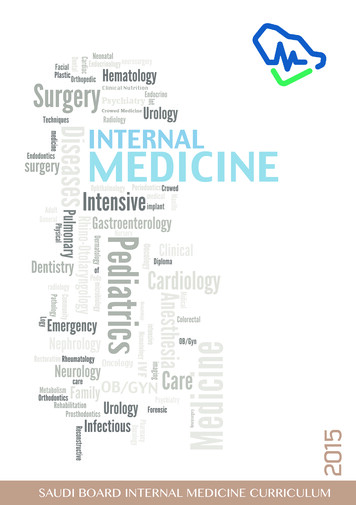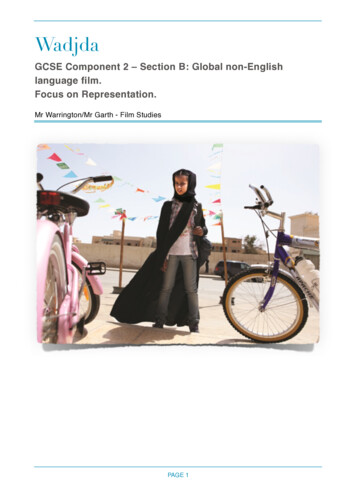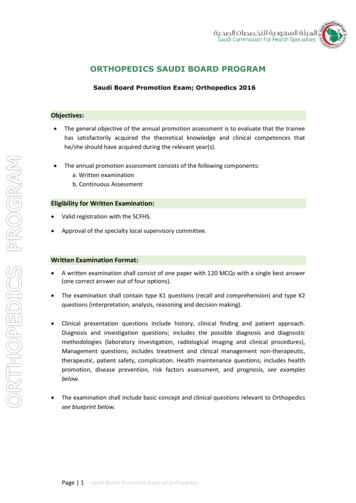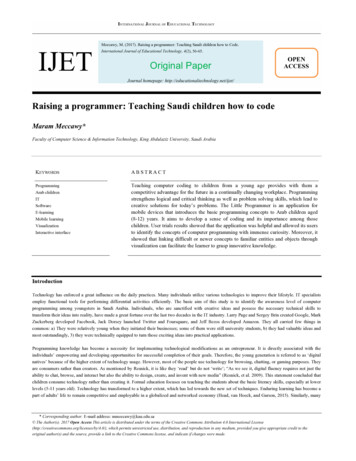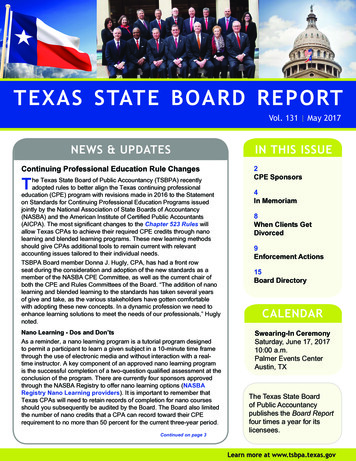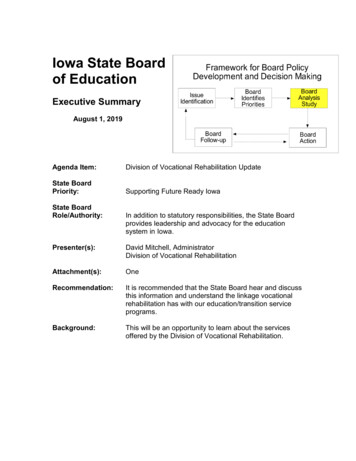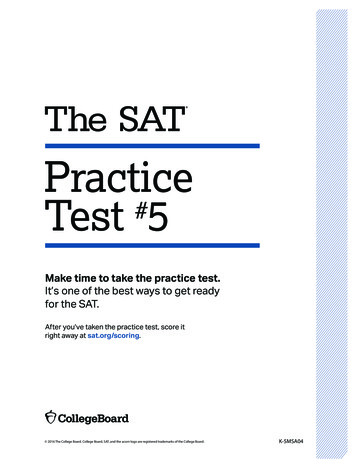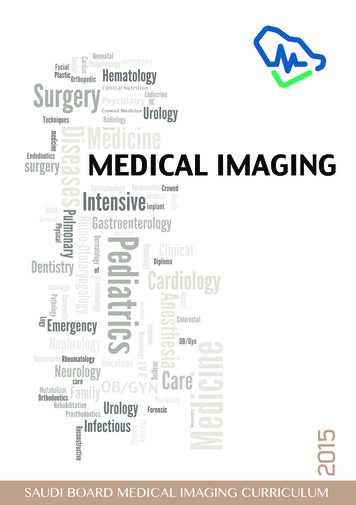
Transcription
SAUDI BOARDMEDICAL IMAGING Curriculum2015PreparationCurriculum Scientific GroupPROF. NIZAR AL NAKSHABANDIDR. MISHAAL AL SHAALANPROF. IBRAHIM AL ORAINYDR. YUSUF AL KADHIResident RepresentativeDR. ADBULAZIZ AL TASANSupervisionCurriculum SpecialistDR. ZUBAIR AMINDR. SAMI AL SHAMARRIReviewed and ApprovedRadiology Scientific CouncilDr. Yousif AlkadhiDr. Ibrahim AlorainyDr. Zakryea AlsafranDr. Ahmad AlnamiDr. Ali AlorfDr. Ghazi AlshumraniDr. Nizar AlnkshabandiDr. Turki AlhazmiDr. Meshal AlshalanDr. Abdulqader AlkenawiDr. Athar RadwiDr. Hisham AlshalanDr. Saleh Alsumayer1
SAUDI BOARD MEDICAL IMAGING CURRICULUM2015COPYRIGHT AND AMENDMENTS 2015 Saudi Commission for Health Specialties. All rights reserved.This material may not be reproduced, displayed, modified, ordistributed without written permission from the copyright holder.No other use is permitted without prior written permission fromthe Saudi Commission for Health Specialties. For permission,contact the Saudi Commission for Health Specialties, Riyadh,Kingdom of Saudi Arabia.Any amendment to this document must be approved by theSpecialty Scientific Council and the Executive Council of theCommission. Amendments shall be considered effective from thedate on which the revised electronic version is published on thecommission’s website, unless a different implementation date hasbeen agreed upon.Correspondence:Saudi Commission for Health SpecialtiesP.O. Box: 94656Postal Code: 11614Contact Center: 920019393E-mail: systemadmin@scfhs.orgWebsite: www.scfhs.org.saFormatted and Designed by:Manoj Thomas Varghese, CMT (SCFHS)2
SAUDI BOARD MEDICAL IMAGING CURRICULUM2015Table of ContentsSAUDI BOARD 1Acknowledgments 6SECTION 1 81.1 Introduction 8SECTION 2 92.1 Training Program 92.1.1 Objectives 92.2 Structure of the Training Program 102.2.2 Contents of Training 102.2.2 Rotation Design 132.3 Admission Requirements 142.4 Training Requirements 142.5 Vacations, Holidays, Special Circumstances, and On-CallDuties 15SECTION 3 183.1 General Radiological Objectives (competencies) 183.1.1 Medical Expert 183.1.2 Communicator 193.1.3 Collaborator 203.1.4 Manager 203.1.5 Health Advocate 203.1.6 Scholar 213.1.7 Professional 223
SAUDI BOARD MEDICAL IMAGING CURRICULUM20153.2 Rotational Objectives 223.2.1 CT Body Rotation 223.2.2 Breast Imaging 253.2.3 General Diagnostic Ultrasound 283.2.4 Fluoroscopy/Emergency Radiology Rotation 363.2.5 Body Magnetic Resonance Imaging Rotation 393.2.6 Nuclear Medicine/PET Imaging Rotation 413.2.7 Neuroradiology Rotation 513.2.8 Interventional Radiology Rotation 543.2.9 Musculoskeletal (MSK) Rotation 573.2.10 Pediatric Rotation 593.2.11 Chest Imaging Rotation 623.2.12 Cardiac Imaging Rotation 653.2.13 General MRI Rotation 683.2.14 General CT Rotation 69SECTION 4 724.1 Non-rotational Skills 724.1.1 Contrast Media Management 724.1.2 Imaging Examination Techniques 734.1.3 On-call Duties 764.1.4 Quality Improvement 784.1.5 Radiology Research Skills 844.1.6 Reporting skills 864.1.7 Sedation and Analgesia 884.1.8 Imaging Informatics and Advanced Visualization 904.2 Academic Activities and Courses 924
SAUDI BOARD MEDICAL IMAGING CURRICULUM20154.2.1 Didactic Academic Activities 924.2.2 Courses 1094.2.3 Workshops 1304.3 Universal Topics 1334.3.1 Intent 1334.3.2 Development and Delivery 1334.3.3 Assessment 1334.3.4 University Topics Module 134Module: Introduction 134Module: Cancer 134Module: Diabetes and Metabolic Disorders 134Module: Medical and Surgical Emergencies 134Module: Acute Care 134Module: Ethics and Healthcare 134Assessment 136Evaluation 139APPENDICES 1415
SAUDI BOARD MEDICAL IMAGING CURRICULUM2015AcknowledgmentsThe radiology core curriculum team appreciates the valuablecontributions and feedback from the following members of thesupervisory committee and the curriculum workshop team duringthe construction of this manual:Dr. Ahmad Al Naami, Prof. Abdulraouf Maimani, Dr. Ali Al Orf, Dr.Ghazi Al Shamrani, Dr. Metab Al Kubayyer, Dr. Donya Al Hasan,Dr. Zakaria Al Safran, Dr. Abdullah Al Dosary, Dr. Saad Al Qahtani,Dr. Abdulrahman Al Nuaim, Dr. Faisal Bin Hussain, Dr.Mohammad Al Otaibi, Dr. Hani Al Hujaili, Dr. Yaser Asiri, and Dr.Nuha Khoumais. This work could not have been accomplishedwithout their support. We would also like to acknowledge that theCanMEDS framework is a copyright of the Royal College ofPhysicians and Surgeons of Canada, and many of the descriptionsand radiology competencies have been acquired from theirresources.Finally, we acknowledge the Saudi Medical Physics Society andMr. Faisal Al Fayez for his secretarial assistance.6
SAUDI BOARD MEDICAL IMAGING CURRICULUM20157
SAUDI BOARD MEDICAL IMAGING CURRICULUM2015SECTION 11.1 IntroductionMedical Imaging is an ever-evolving and growing field that is advancing atan incredible rate, with not only an emergence of new subspecialties overthe past few years but also a redefinition of existing specialties.Therefore, the training course for radiologists must be comprehensive anddynamic in order to integrate established academic knowledge andpractical proficiency with the ever-growing body of research that drivesthe field, thus encouraging trainees to invest in comprehension of researchand its methodology. The Saudi Board of Radiology aims to not onlyproduce competent radiologists who are capable of performing variousdiagnostic and therapeutic tasks but also build a culture of continuedexcellence and the drive to perform crucial and beneficial research, thusensuring that the needs of the Kingdom are best served with a strongunderstanding of the cultural, ethical, and socioeconomic milieu of theregion.8
SAUDI BOARD MEDICAL IMAGING CURRICULUM2015SECTION 22.1 Training ProgramThe training program is a 4-year, full-time residency in accreditedinstitutions, with continuous and final evaluations by way of examinations.The program comprises training to acquire cognitive and technical skillsand to understand how they relate to the physics, applied anatomy,pathology, and physiology of health and disease.The training involves practical procedures and interpretation methodstaught in a sequential and integrated manner through lectures, tutorials,seminars, and, above all, apprenticeship that provides hands-onexperience.2.1.1 ObjectivesThe Saudi Board of Radiology is built upon the foundation that theradiologist must be a Medical Expert, Communicator, Collaborator,Manager, Health Advocate, Scholar, and Professional. This ensures thateach candidate can provide the optimum level of care and expertise tosustain and advance the profession. The objectives can be further brokendown into general and radiology-specific requirements.9
SAUDI BOARD MEDICAL IMAGING CURRICULUM20152.2 Structure of the Training ProgramThe program comprises 4 years of training structured into four levels (R1–R4). Each level facilitates the acquisition of basic, relevant, and appropriateacademic knowledge, along with the integration and application of thisknowledge as part of standard radiological practice.Theoretical knowledge shall be acquired through lectures, tutorials,seminars, and assignments, while professional and practical radiologicalskills will be acquired through on-the-job experience and apprenticeship.On-call duties are compulsory.2.2.2 Contents of TrainingFirst Year (R1)The first year begins with month-long introductory rotations in general CT,ultrasound, chest, emergency radiology, and fluoroscopy. These rotationsare designed to introduce the resident to areas of imaging frequentlyencountered during on-call duties. During this time, the resident will learnradiology terminology and how to structure a report.A key component of this introductory phase includes the basics of PACS,image manipulation, and communication skills.Students should concentrate on mastering the basics, including imagingbased anatomy, imaging physics, radiation safety, contrast administration,and all related issues, with focus on ultrasound and MRI physics andtechniques during their respective introductory rotations.The remainder of R1 focuses on the “building blocks” of radiology. Therotations are as follows.Two months: ultrasound, chest, and fluoroscopy/ERThe entire first rotation should focus on ultrasound, with exclusive handson scanning of patients.One month: musculoskeletal radiology, neuroradiology, general CT,general MRI, body CT, and nuclear medicine.Second Year (R2)The second year concentrates on further building of resident knowledgeand experience in cross-sectional imaging. The knowledge gained in the R110
SAUDI BOARD MEDICAL IMAGING CURRICULUM2015rotations is enhanced and integrated into these rotations. This year alsointroduces the residents to pediatric radiology through a 2-month blockrotation that aims to educate the trainees in specific pediatric imagingtechniques and help them acquire the necessary skill sets to best serve thisunique population. The residents are also introduced to breast imaging.During this year, the residents are encouraged to enroll in courses on thebasics of conducting research as well as evidence-based medicine courses.These will prepare the residents for the QI/research rotation during thefollowing year.The typical rotation design for this year is as follows.Two months: pediatric radiology, chestOne month: ultrasound, body MRI, nuclear medicine, breast imaging,musculoskeletal radiology, neuroradiology, body CT, and an electivesubject.Third Year (R3)The third year introduces the residents to vascular and interventionalradiology through a 2-month dedicated rotation with hands-on training invarious radiological procedures.The year also introduces a 1-month rotation in cardiac imaging, which is acomprehensive rotation wherein the residents work closely with cardiacradiologists and cardiologists, thus covering cardiac CT, cardiac MRI, andnuclear cardiac imaging.Residents also spend a month in research and quality improvement, wherethey are given the opportunity to either conduct a research project underfaculty supervision, with the aim of producing publishable material, orundertake a departmental quality improvement project. There is anelective month during the R3 year. If desired, this can be used to attend a4-week radiology/pathology course at the American Institute of RadiologicPathology (AIRP), which is conducted in the USA under the auspices of theAmerican College of Radiology.The typical rotation design for this year is as follows.11
SAUDI BOARD MEDICAL IMAGING CURRICULUM2015One month: body CT, nuclear medicine, ultrasound, breast imaging,neuroradiology, fluoroscopy/ER, cardiac imaging, research/QI, andpediatric radiology.Two months: interventional radiologyFourth Year (R4)This year offers rotations that review the core radiology knowledge and isintended to round off the consultancy skills of senior residents and serveas a foundation for the review of content relevant for examination andcertification purposes. This year encourages residents to tailor theirrotation design to include those areas that best suit their personal learningobjectives and future career directions. This flexibility is implemented byoffering 2 months of elective rotations.The rotations serve to consolidate consultancy skills in diagnostic imaging,because they permit graded responsibility and semi-independent reportingunder staff supervision, fostering a “ready for practice” model for thesuccessful completion of R4. During these months, the senior resident aimsto perform the responsibilities and carry the workload of a junior staffradiologist. Review of core material for exam preparation through “on-thejob” exposure to important aspects of all imaging modalities is advocated.The fourth year also debuts exposure to PET/CT imaging during the NMrotation. The residents are expected to familiarize themselves with thephysics as well as the technical aspects of this imaging modality, includingimaging protocols, indications, contraindications, patient preparation, andimage interpretation.The rotation design for this year includes 1-month rotations in body CT,chest, nuclear medicine (including PET/CT), breast imaging,neuroradiology, pediatric radiology, interventional radiology, body MRI,ultrasound, and musculoskeletal radiology. The year is rounded off with 2months of elective rotations.The inclusion of time for OB examinations in ultrasound exposure is highlyencouraged.R4 residents should supervise/teach junior residents and start conductingclinical–radiological meetings under staff supervision.12
2015SAUDI BOARD MEDICAL IMAGING CURRICULUM2.2.2 Rotation DesignRotationsBody CTGeneral FL/ERBreast ImagingGeneral MRIBody lude 121248AIRP optional13
SAUDI BOARD MEDICAL IMAGING CURRICULUM20152.3 Admission RequirementsIn accordance with and without contradiction to the SCFHS training rulesand regulations, the following requirements must be fulfilled by anycandidate accepted into the training program: All candidates must hold a medical degree such as an M.B.B.S. orits equivalent from a university recognized by the commission.All candidates must have completed a 12-month rotatinginternship.All candidates must have passed the Saudi Medical LicensingExam (SMLE).All candidates must provide a comprehensive CV with referencesfrom two (2) consultants, preferably from the field of radiology,who should provide recommendation letters stating thesuitability of the candidate for training in radiology.All candidates must provide a letter from a sponsoringorganization, approving and pledging support for the candidate’stotal period of training, i.e., 4 years, and for sponsored positions.All candidates must sign a written pledge to abide by the rulesand regulations of the training program and the Saudicommission.All candidates must be registered as training radiologists at theSaudi Commission for Health Specialties (SCHS).All candidates must have basic life support certification andmalpractice insurance.2.4 Training RequirementsThis is a joint training program, and residents are expected to show totalcommitment toward the program and the SCHS.Training should be conducted in institutions accredited for training by theSaudi Board of Radiology. All candidates will rotate through most, if not all,of these institutions during their training. Training will be comprehensive,involving all subspecialties and including inpatients, outpatients, andemergency (on call) cases. Residents must be actively involved in patientcare, so that they acquire hands-on experience. The degree of involvementand responsibility will be gradually adjusted according to the level of the14
SAUDI BOARD MEDICAL IMAGING CURRICULUM2015trainee and their general competence. Trainees will be bound by the rules,regulations, and obligations set by the SCHS.2.5 Vacations, Holidays, Special Circumstances,and On-Call Duties In accordance with and without contradiction to the SCHStraining rules and regulations, residents are entitled to 30 days ofvacation each year, including intervening weekends.o Local training committees/centers may elect toimplement a certain minimum number of days forvacation approval.o The resident cannot take more than 5 working days offduring any single rotation, including Eid days. This limitmay be exceeded in only two circumstances: If the Eid vacation time designated for staffby the training center exceeds 5 days, inwhich case the resident has the option totake those additional days off from his/herannual leave balance. If there is an approved course/activityconducted by the residency program thatrequires resident attendance. These days willnot be deducted from the resident’s annualleave balance.However, in either situation, the total number of daysoff during any rotation must not exceed 10 workingdays, with no more than five representing annualvacation days.Should a resident choose to drop a rotation, the rotation must becompensated before the completion of training by deductionfrom the annual vacation days. Similar rules will apply if theresident needs to compensate for a failed rotation.If more than three rotations are dropped and/or failed, anadditional year of compensation training will be required.Sick leaves and maternity leaves will be compensated during orat the end of training.15
SAUDI BOARD MEDICAL IMAGING CURRICULUM 2015After the fourth month of training, on-call duties will commenceand should be no less than three calls and no more than 8 callsper month. Only first-on-call residents are released from allclinical duties on the day following their discussion with andreceipt of on-call cases from the attending consultant(s).Continuation of one's daily duties is, however, encouraged toafford continuous care to patients and enhance clinical exposure.Senior residents who are second-on-call should attend patientswith the first-on-call residents as needed (review must notexceed 2 hours per case) or provide immediate presence whenrequested and for ambiguous cases. They must also accompanythe first-on-call residents during the case discussion with theattending consultant(s) the following morning. However, secondon-call residents will not be permitted to take the followingworking day off unless objective and verified circumstances canbe presented to the program director.16
SAUDI BOARD MEDICAL IMAGING CURRICULUM201517
SAUDI BOARD MEDICAL IMAGING CURRICULUM2015SECTION 33.1 General Radiological Objectives(competencies)3.1.1 Medical ExpertJunior Level Knowledge To recognize basic radiological anatomy and variants thereof.To understand the basic physical principles behind radiologicaltechniques.To learn the indications and absolute and relativecontraindications for various contrast media.To recognize the appropriate indications and contraindications ofvarious radiological techniques.To recognize radiological emergencies and common pathologiesand understand their management.To list the most important differential diagnoses for variousimaging findings.Junior Level Skills To identify and manage reactions to contrast media.To appropriately perform and prescribe radiologicalexaminations.To recognize and describe imaging techniques and findings.To generate an accurate and informative radiology report.To perform basic imaging-related non interventional procedures.To perform basic post-processing procedures and image analysis.Senior Level Knowledge To recognize detailed and complex radiological anatomy.To understand the advanced physical principles behindradiological techniques.To understand advanced imaging techniques and technicalproblem-solving approaches.18
SAUDI BOARD MEDICAL IMAGING CURRICULUM 2015To recognize unusual imaging presentations of commonpathologies.To develop in-depth fund of differential diagnoses for variousimaging findings.To recognize and recommend the most appropriate next step inpatient managementSenior Level Skills To perform basic imaging-related interventions and advancednon interventional procedures.To generate an appropriate opinion about complex imagingfindings.To perform advanced post-processing procedures and imageanalysis.To acquire and practice skills related to basic imaging informatics.3.1.2 CommunicatorJunior Level To demonstrate effective communication skills while dealing withpatients and their families, staff members, and referring clinicalservices.To communicate critical findings directly to the referringphysician in a timely fashion.To document pertinent conversations with the clinician in thereport.To generate well-organized reports, accurately conveying therelevant findings, diagnosis, and recommendations.Senior Level To communicate effectively and empathetically with patients andtheir families.To recognize the physical and psychological needs of patientsundergoing radiological investigations and/or treatment andtheir families, including the needs of culture, race, and gender.To develop effective oral skills for individual consultations andcase presentations, radiology conferences, and scholarly work.19
SAUDI BOARD MEDICAL IMAGING CURRICULUM20153.1.3 CollaboratorJunior Level To demonstrate good consulting skills when interacting withother physicians and health team members.To interact appropriately with radiology department and hospitalstaff members, demonstrating a team approach toward patientcare.Senior Level To work effectively as part of a multidisciplinary team in dailypatient management.To actively participate in multidisciplinary team meetings.To work with clinical colleagues on research or qualityimprovement projects.3.1.4 ManagerJunior Level To manage time effectively in order to ensure productivenessand timeliness of service provision.To consider available imaging resources when planning andrecommending patient care, using them effectively andefficiently.To prioritize radiological studies based on urgency and clinicalneed.To manage night duty responsibilities efficiently and effectively.Senior Level To effectively manage technologists, nurses, and junior staffduring the delivery of appropriate patient care.To supervise the night duty activities of junior residents.3.1.5 Health AdvocateJunior Level To provide a safe environment for patients and staff members.To minimize risk to patients undergoing radiological studies.20
SAUDI BOARD MEDICAL IMAGING CURRICULUM 2015To apply the ALARA principle.Senior Level To recognize quality improvement opportunities within theimaging environment.To apply quality improvement methods for the enhancement ofpatient and staff safety.To apply appropriate and advanced radiation minimizationstrategies during patient care.To participate in imaging-related community or healthcarefacility awareness efforts.3.1.6 ScholarJunior Level To set personal learning goals and objectives during rotations.To focus on basic introductory texts relevant to each rotation.To understand methods for extracting scientific information fromthe medical literature.To teach medical students, technologists, and peers.To contribute to teaching files.Senior Level To assume a leadership role while teaching others, withteaching/supervision of junior residents on rotation, electivestudents, and off-service residents.To know how to search for information about rare or unusualcases.21
2015SAUDI BOARD MEDICAL IMAGING CURRICULUM To understand methods for executing good clinical researchprojects.To demonstrate the ability to critically appraise journal articles.To practice evidence-based medicine.3.1.7 Professional To adhere to relevant Islamic principles, medical ethics, andmedicolegal requirements.To act as a role model and mentor for junior staff.To deliver the highest-quality care with integrity, honesty, andcompassion.To exhibit appropriate personal and interpersonal professionalbehavior.To assess one’s own performance, strengths, limitations, andweaknesses.To maintain patient and family confidentiality.To demonstrate a sense of accountability.To demonstrate a commitment to his/her patients, profession,and society and to his/her own personal development.3.2 Rotational Objectives3.2.1 CT Body RotationNumber ofrotationmonthsR1R2R3R4Total11114In addition to the general competencies addressed under 3.1 GeneralRadiological Objectives (competencies), the following competencies arealso required for this rotation.Medical ExpertJunior Resident Knowledge To recognize basic radiological anatomy and variants based onCT, including but not limited to internal viscera, abdominal22
SAUDI BOARD MEDICAL IMAGING CURRICULUM 2015organs, omentum, mesentery and peritoneum, abdominalvessels, and abdominal spaces.To understand the basic physical principles behind CT and theassociated protocols and techniques, effects of modifyingscanning parameters on image quality, and patient radiationdose.To understand the indications and absolute and relativecontraindications for various contrast media.To recognize the appropriate indications and contraindicationsfor various abdominal CT protocols.To recognize abdominal radiological emergencies and commonpathologies and understand their management.To list the most important differential diagnoses for various CTimaging findings.Junior Resident Skills To identify and manage reactions to contrast media.To appropriately perform and prescribe radiologicalexaminations.To recognize and describe imaging techniques and findings.To generate an accurate and informative radiological report.Senior Resident Knowledge To recognize detailed and complex anatomy on CT images.To understand the advanced physical principles behindradiological techniques (iterative reconstruction versus filteredback projection).To understand advanced imaging techniques and problemsolving methods (dual energy imaging techniques).To recognize unusual imaging presentations of commonpathologies.23
SAUDI BOARD MEDICAL IMAGING CURRICULUM 2015To develop a strong fund of differential diagnoses for variousabdominal CT findings.To recognize and recommend the most appropriate next step inpatient management.Senior Resident Skills To generate an appropriate opinion about complex imagingfindings.To perform common post-processing tasks for abdominalimaging studies, including multiplanar reformation (MPR),maximum intensity projection (MIP), minimum intensityprojection (MinIP), and vessel analysis.To acquire and practice basic skills related to imaging informatics(fetching and transferring images to and from advancedvisualization systems).Examples of useful reading material Fundamentals of body CT, 2014, by W. Richard Webb andWilliam E. Brant, MD, ISBN-13: 978-0323221467; ISBN-10:0323221467; Edition: fourthGastrointestinal Imaging: The Requisites, 2013, by Giles WBoland, ISBN-13: 978-0323101998; ISBN-10: 0323101992;Edition: fourthTextbook of Uroradiology, 2012, by Reed Dunnick, MD and CarlSandler, MD, ISBN-13: 978-1451109160; ISBN-10: 1451109164;Edition: fifthCross-Sectional Imaging of the Abdomen and Pelvis: A PracticalAlgorithmic Approach, 2015, by Khaled M Elsayes, ISBN-13: 9781493918836; ISBN-10: 1493918834; Edition: 2015th24
2015SAUDI BOARD MEDICAL IMAGING CURRICULUM3.2.2 Breast ImagingNumber of rotationmonthsR1R2R3R4Total01113In addition to the general competencies addressed under GeneralRadiological Objectives, the following competencies are also required forthis rotation.By the end of training, the residents must demonstrate basic knowledge,technical skills, and the attitude necessary for the competent performanceof all aspects of breast imaging.Medical ExpertJunior Resident Knowledge To demonstrate an understanding of appropriate positioning andbasic mammographic techniques.To recognize a good-quality mammogram.To recognize commonly encountered physiological breastchanges.To demonstrate an understanding of important technical andphysical factors important for obtaining an optimalmammographic study.To recognize the need for diagnostic mammography, includingadditional mammographic views as ographic/sonographic features of malignant and benignbreast diseases.To demonstrate the ability to develop a sound approach towardthe assessment of breast calcifications and masses.To demonstrate the ability to understand the role of ultrasoundin breast imaging.To demonstrate an understanding of the indications forstereotactic biopsy, US-guided core biopsy, and cyst aspiration.To demonstrate familiarity with evaluation of the male breast.25
SAUDI BOARD MEDICAL IMAGING CURRICULUM2015Junior Resident Skills To describe the mammographic/sonographic features ofmalignant and benign breast diseases.To re
pediatric radiology. Two months: interventional radiology Fourth Year (R4) This year offers rotations that review the core radiology knowledge and is intended to round off the consultancy skills of senior residents and serve as a foundation for the review of con
